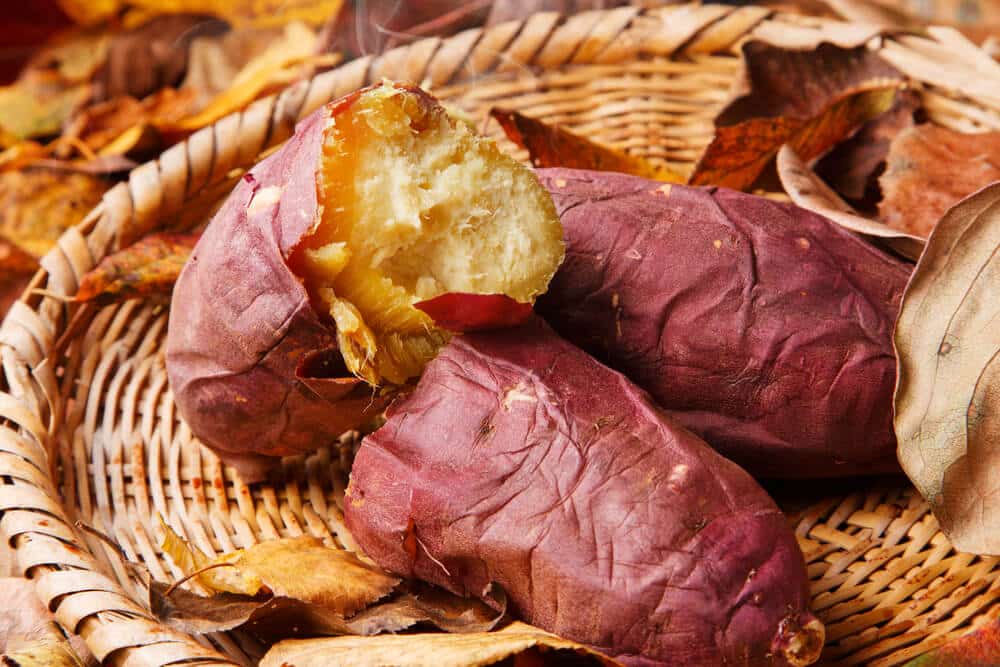
On a cool autumn evening or a frigid winter night in most cities in Japan, an ethereal voice can be heard. “Yaaaaaki-Imoooo… Ishiyaki-Imoooo!” (“Baked potato.. Stone-baked potato!). Allow yourself to be lured in by the angelic sounds, and you will soon pick up the scent of something sweet roasting away.

Like a moth to the flame, you’ll be drawn to an unassuming kei truck with an (almost guaranteed) elderly couple serving up baked potatoes out of the back. I don’t know if it is the heat of the stones on which the potato is baked, the way the starch maintains temperature like a hot coal, or the warmth radiating from the elderly couple, but nothing will fight off the cold on your walk home better than a baked potato in Japan.
What’s so special about a baked potato?
Let’s get this straight—yaki-imo is not your grandma’s butter-and-sour-cream, heart-attack-inducing, cholesterol bomb. Unlike traditional baked potatoes in the West that do everything to mask the bland flavor of your standard potato, yaki-imo is a call to simplicity, and the beauty it reveals. True to Washoku style, baked potatoes in Japan do not add any butter or spices; they simply throw a washed sweet potato on to some coals and let nature do its work.
There are four types of sweet potatoes that are commonly used for yaki-imo: Satsuma (さつま芋), Annou (安納芋), Milk Sweet (ミルクスイート), and Beni Haruka (紅はるか). Satsuma is the most popular. It provides a starchy punch with a very gentle sweetness, but it is easily overcooked—an overcooked Satsuma potato will leave your mouth drier than the Tottori Sand Dunes.
Of the four, Annou is the stand out for uniqueness of flavor and texture. When cooked right, it will be incredibly tender, practically melting in your mouth, and have a delectable sweetness that’s reminiscent of a good pastry. It reminds me of Thanksgiving yams.

Where to get it
If you want “the real thing”, there’s no better place to get a yaki-imo than from a truck on the side of the road. They usually gather near nightlife areas or around train stations during the colder months. If you can’t find a truck, most supermarkets will have them in the produce section (usually accompanied by a stereo playing a yaki-imo jingle, but not always). Prices of the various kinds of potatoes will vary with the time of the year, but in general, Satsuma potatoes will be the cheapest (the pictured yaki-imo is a Satsuma potato for 238 yen).
For those of you with aspiration to be a yaki-imo food trucker, there are many ways to practice the art at home. An oven set from 160 to 180 degrees celsius is the most obvious, but you can also get more creative. If you have small potatoes or are willing to cut them up, a rice cooker will do the job just fine!

In fact, the rice cooker is excellent for preserving the water which helps to bring out the sugars. Another option is to wrap the potato in foil and throw it on some charcoals in the barbecue. Or better yet, do as the Japanese do; bake your potato on the gas stove and kill two birds with one spud as you heat your home, too! Wrapping the potato with a wet paper towel and aluminium foil will help to preserve moisture. Use a toothpick to check when it has cooked all the way through, or get a rough estimate with a gentle squeeze.
Time to Chow Down
Yaki-imo are made to be a convenient energy pack somewhere on the snack-to-meal scale. It is rare to receive a potato that has just been baked (and is too hot for consumption); instead, they have usually been kept at a lower temperature on a bed of warm stones. This is because you are generally expected to eat them within a short amount of time—they will last a day or two in the refrigerator, as well. If the potato has been cleaned prior to baking, then it’s no problem to eat the skin—in fact, I prefer it. If that does not sound appealing, another benefit of the baking is that it makes the skin easy to peel off.
As with most Japanese dishes, yaki-imo’s availability is dictated by the season. It is usually a late fall and winter food–aligning with annual potato harvests (for reference, my local supermarket began sales on September 24th). This is especially true with the trucks; the warmer it gets, the harder it is to find them.
You can get a feeling for the cultural love of Yaki Imo from this sweet sad song, and animated video!
Apart from the agricultural limitations, the seasonal availability make sense; you wouldn’t want to walk around in the heat of August carrying a miniature oven any more than eating kakigori in the middle of winter. However, if you are in Japan in the yaki-imo “off season”, you may still be able to find them at bigger supermarket chains.




